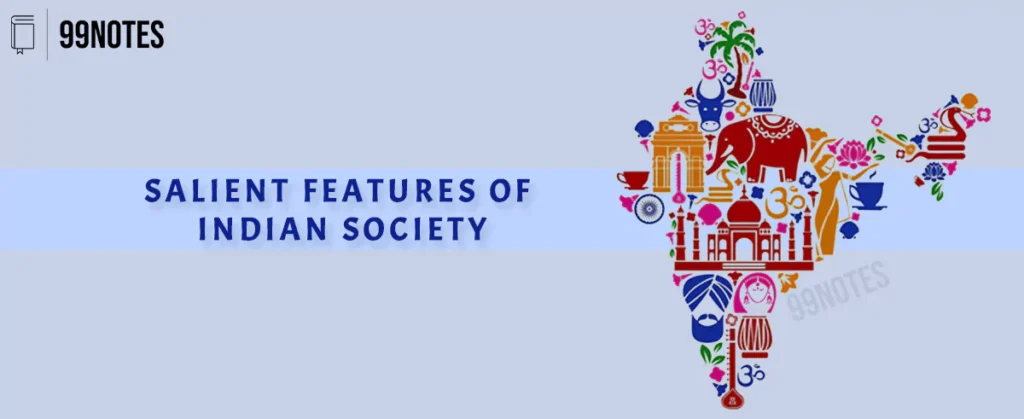
Salient Feature Of Indian Society UPSC Notes Free Download
More About Salient Feature Of Indian Society
It is challenging to identify the features of Indian society due to the fact that it is comprised of a wide variety of identities, races, languages, faiths, and dietary preferences. The chronicles of history attest to the reality that communities that exerted great effort to preserve their distinctions were broken in the process.
To simplify the issue and make it easier to comprehend, the characteristics of Indian society may be divided down into the following categories:
- Multi Ethnic Society
- Multilingual Culture
- Multi Religious Society
- Multi- Caste
- Unity Within Difference
- Patriarchal Society
- Tribes
- Family
- Kinship Method
- The equilibrium of spirituality and materialism
- The equilibrium of Individualism and collectivism
- Coexistence of modernism and traditionalism
India is a diverse and complex society with a long and rich history. Some of the salient features of Indian society include:
- Diversity: India is home to a wide range of ethnic, linguistic, religious, and cultural groups, which coexist and interact with each other in various ways.
- Caste system: The caste system is a traditional social hierarchy that has shaped Indian society for centuries. It is based on the principles of social stratification and hierarchy, and it determines the social, economic, and political status of individuals within the society.
- Family structure: The family is the basic unit of social organization in India, and it plays a central role in shaping the lives of individuals. Joint families, in which multiple generations live together, are common in India, and the oldest male member is usually the head of the household.
- Religion: India is a religiously diverse country, with Hinduism, Islam, Christianity, and Sikhism being the major religions. Religious beliefs and practices play a significant role in shaping the values and cultural practices of Indian society.
- Gender roles: Gender roles and expectations have traditionally been defined in India, with men being seen as the breadwinners and women being responsible for household duties and childrearing. However, there has been a shift towards more gender-equal roles in recent years.
- Social mobility: Social mobility, or the ability to move up or down the social hierarchy, is limited in India due to the influence of the caste system and other social and economic factors. However, there are some avenues for upward mobility, such as education and entrepreneurship.
The Characteristics of Indian Society:
Indian culture has one of the longest history among various world cultures. For ages, India accommodated different elements of Society without letting them lose their separate identities.
India has a vast cultural & socio-economic diversity
- Multi-Ethnicity: An ethnic group is usually based on a common language or dialect, history, Society, or culture.
- Multi-Lingual Society – 22 languages are recognized in the 8th schedule as the official languages of the country. However, more than 500 dialects are spoken in India.
- Multiple classes: In terms of Income and profession, Indian Society is highly diverse.
- Multi-religious Society: India is home to four major world religions: Hinduism, Buddhism, Jainism and Sikhism. Hundreds of belief systems are followed in India.
- Multi-cultural Society: India has many festivals and rituals celebrated throughout the year, which help preserve cultural heritage and traditions.
- Unity in Diversity: It is a term that implies unity among people with diverse cultural, religious, and other demographic differences etc. India is a melting pot of hundreds plus different languages and 500-plus tribes.
- Patriarchy: Patriarchy is a social system upholding the idea that men are superior to women and treat women as second-class citizens. Male dominance over women is degrading to women, hindering the social and emotional development of the fairer sex of Society.
- Tribes: India has the second largest tribal population in the world after Africa. As per the 2011 census, the tribal population comprises 8.9% of the total population in India. The people belonging to the tribal group have rich traditions, cultures and heritage with unique lifestyles and customs.
- Kinship Method: it is a structured system of statuses and roles and of relationships in which kin (Primary, Secondary, tertiary and distant) are bound to one another by complex interlocking ties. Kinship is one of the significant institutions of Indian Family Tradition.
- Coexistence of modernism and traditionalism: As there are several gyms with modern equipment across the country, yoga is still mushrooming on a large scale. Indianization of the western food (e.g., Mc Aloo Tikki). Indo-western fusion of the dressing style (for Instance Jeans with kurta, etc).

